|
A crop picture at Oliver’s Castle on April 24, 2017 seems to show the
schematic image of a “total solar eclipse”, with 27 short “rays of
light” or “Bailey’s beads” arranged regularly around the outside. It may
refer to an upcoming solar eclipse on August 21, 2017. Such “beads” also
resemble a ring of 28 “Aubrey holes”, which were used to predict
eclipses at Stonehenge or other megalithic sites long ago.
A new crop picture which appeared near Oliver’s Castle on April 24, 2017
looks very good on the ground, in terms of its gently-flattened lay (see
photos or
www.youtube.com or
www.youtube.com). Most
oilseed rape plants there remain fluffy and partly erect, just as if
they had been patterned gently by paranormal energies, rather than being
pressed hard against the ground by “rope and boards”.
The visual impression of a “yellow, shining Sun”
The new crop picture shows 27 “small circles” of erect standing crop, as
well as one large, thin circle of flattened crop, around its outer
perimeter. Those 27 “small circles” are interspersed with 27 “short rays
of light”. These two motifs together give the visual impression of a
“yellow, shining Sun”.
Quite surprisingly, it appeared in the same field where another crop
picture, which showed a series of “lunar crescents” arranged in
parallel, appeared on April 15, 2007, just tens of meters away (see
www.lucypringle.co.uk).
Perhaps we are being asked by the crop artists to combine both crop
pictures from 2017 and 2007, in order to understand more clearly what
they are trying to tell us? Another recent crop picture, which appeared
near the top of Waden Hill on April 22, 2017 (see
waden hill),
was drawn not far from where a similar field image had appeared in April
of 2008 (see
www.lucypringle.co.uk).
When two crop pictures from Oliver’s Castle in 2017 or 2007 are studied
together, we can see the image of a ”total solar eclipse”
Now when we study both crop pictures together, from the same field on
top of Oliver’s Castle in April 2017 or April 2007, we can see the
combined image of a “total solar eclipse”. Their first crop picture in
2007 showed a series of “lunar crescents” arranged in parallel. It looks
like a “crescent Moon” which is moving slowly toward our Sun, just
before the totality of an eclipse. Their second crop picture in 2017
shows a series of 27 “small circles” or “short rays of light” around the
outside. It looks like a “yellow, shining Sun” which forms the other
part of an eclipse.
In fact, those 27 “small circles”, which are spread along the outer
perimeter of this new 2017 crop picture, resemble the “Baily’s beads of
light” which are seen sometimes during a total solar eclipse. Our Moon
may be surrounded by “Baily’s beads” during any total eclipse of the
Sun:
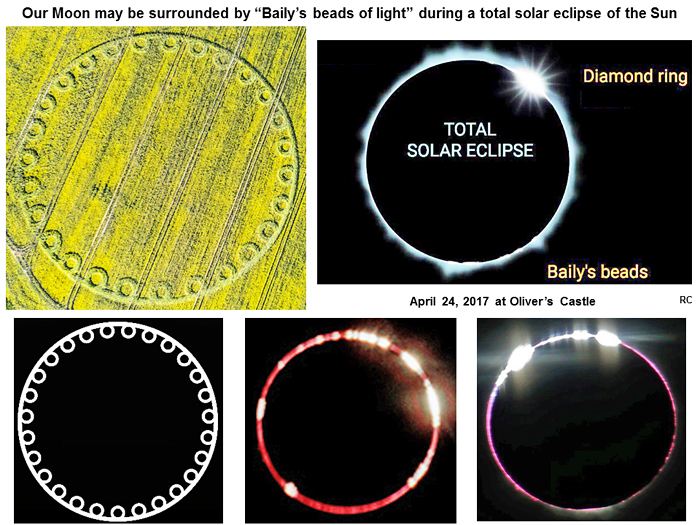
What are “Baily’s beads”?
What are “Baily’s beads”? They were first noticed by the astronomer
Edmund Halley during a total solar eclipse in 1715. Yet the phenomenon
was not understood properly until 1836, when another astronomer called
“Francis Baily” suggested that such “beads of light” were due to an
uneven topography along the surface of our Moon, which causes the Sun’s
background light during an eclipse to pass by its edges in an irregular
fashion. In other words, when
our Moon passes in front of the Sun during a total solar eclipse, then a
rugged and uneven topography along our Moon’s surface allows certain
narrow “beads” of
light to shine toward Earth, in some places but not others (see
www.youtube.com or
observe eclipses).
The next total solar eclipse as seen on Earth will be on August 21,
2017. It will be watched keenly by millions of people across the USA
(see
eclipse.gsfc.nasa.gov
or
total-solar-eclipse-2017-guide). In
fact, it will be the most widely-watched “total solar eclipse” over the
mainland USA for the past 99 years.
Why did those crop artists draw 27 “small circles” around the outside?
Why did those unseen crop artists draw 27 “small circles” or “Baily
beads of light” around the outside of their new crop picture? We cannot
know for sure, but might guess that it was to call attention to the next
“new” phase of our Moon on April 27. That is when our Moon will next
pass between the Sun and the Earth, although it will not “eclipse” the
Sun directly for another four lunar months until August 21:

Since we are discussing “eclipses”, we might expect to see 28 “small
circles” drawn around the outside of this crop picture. That is how many
“holes” or “movable markers” must be arranged into the shape of a
“ring”, in order to predict eclipses by a “sidereal” Sun-Moon calendar
(see
stonehenge eclipses).
The famous “Aubrey holes” at Stonehenge include 56 = 2 x 28 (see
aubrey-holes),
because people who lived in southern England long ago discovered a
slightly more accurate way of making such calculations.
Their 2007 crop picture at Oliver’s Castle showed a series of “lunar
crescents” arranged in parallel
Let us now examine more closely that crop picture from 2007, which was
drawn in almost the same field location as our new example from 2017
(see
www.lucypringle.co.uk). Their
2007 crop picture showed a series of “lunar crescents” arranged in
parallel. These resemble the time-dependent path of our Moon, as it
moves slowly in front of our Sun during a total solar eclipse:
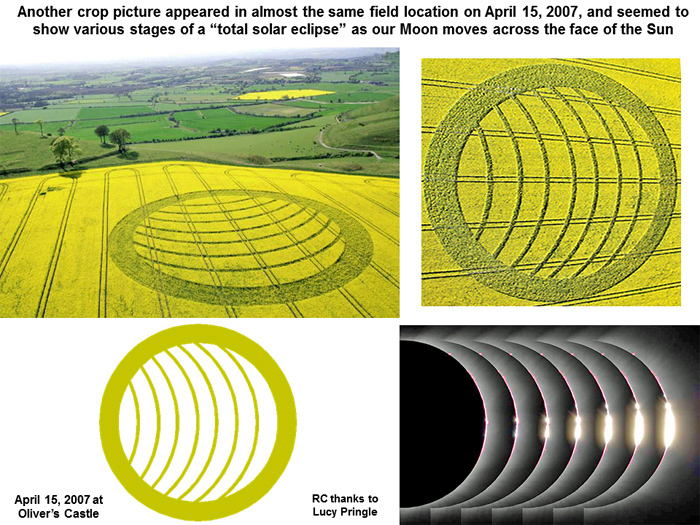
Comparing the field locations of crop pictures at Oliver’s Castle in
April of 2017 or April of 2007
Let us now compare the field locations of those 2017 or 2007 crop
pictures even more accurately and directly. Their 2007 crop picture was
drawn along the same crop tramline as the new one in 2017, except it was
shifted slightly further away from the far side of the field, where we
can see a curving line of six tall trees:
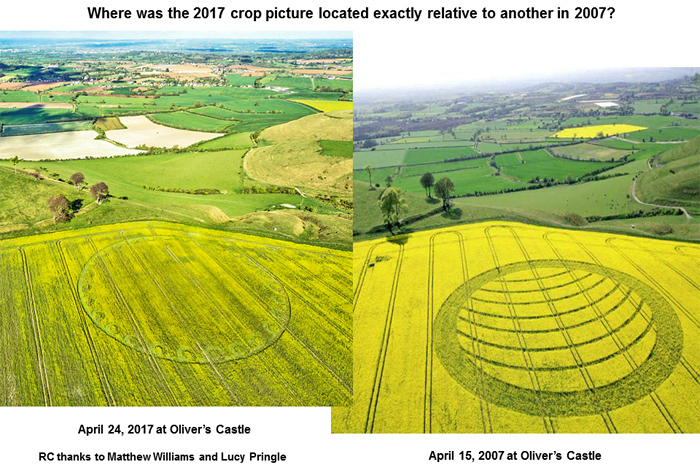
Placing the images of both crop pictures from 2017 or 2007 in their
precise landscape locations using Google Earth
Using Google Earth, we next tried to reconstruct exactly where those two
crop pictures were drawn in the field, whether in 2017 (black and white)
or in 2007 (yellow):
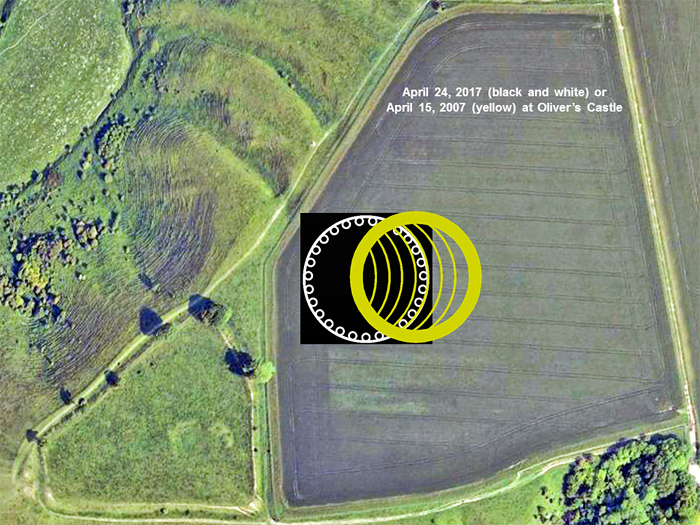
Now we can see that those two crop pictures overlap partly with one
another, just like for a
“Vesica Piscis” (see
Vesica_piscis). This is the kind of
geometry which leads to a “total eclipse”.
Reconstructing the various stages of a “total solar eclipse” by using
both crop pictures together with different overlaps
Finally we decided to reconstruct the various stages of a “total solar
eclipse”, by placing that 2007 crop picture (which represents our
“Moon”) over the new one from 2017 (which represents our “Sun”), while
using a series of different left-to-right overlaps:
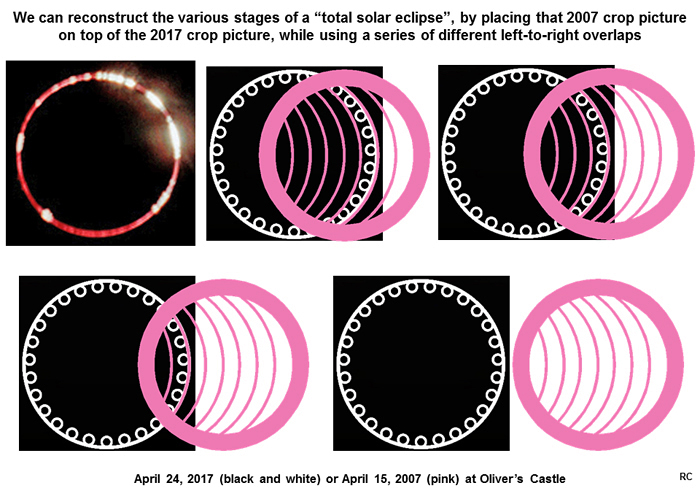
Once our Sun becomes fully eclipsed by the Moon, which is almost exactly
of the same angular diameter when seen from Earth, then we can sometimes
see a series of “Baily’s beads of light” around the surface of our Moon.
Such “beads” come about, because background light from our Sun may pass
by the Moon irregularly, depending on local “high” or “low” features of
the local lunar surface.
Their 2017 crop picture was drawn as the “eye” of a landscape “bird”
which is looking west, toward where a partial solar eclipse will take
place at sunset in England on August 21, 2017
Finally we asked, using Google Earth, where this 2017 crop picture (at
latitude 51.382o N and longitude 1.998o W) might
have been drawn relative to other features of the broad landscape
nearby? By studying such images carefully (not shown), we found that the
2017 crop picture was drawn close to the figurative “eye” of a large
“bird” shape in the landscape. Two large trees and a pointed hill, just
to the west of this crop picture, might be that bird’s “two nostrils”
and “pointed beak”.
Such a metaphorical “bird” should be able to “see” clearly an upcoming
solar eclipse, when he looks westward from anywhere in the USA on August
21, 2017 around 1827 UTC. A partial eclipse may still be seen in
southern England on August 21, low in the west-northwest, from high
viewing locations (see
staging.timeanddate.com or
www.vercalendario.info).
Several other interesting details
Several other interesting details might be mentioned here. First, an
“eclipse” sequence from the introduction to “Star Trek Voyager”
shows a “Baily’s bead of light” at time 1:20 (see
www.youtube.com).
Next, those 27 “small circles” were drawn asymmetrically around the
outer perimeter of this new crop picture, or across five different
tramlines with 8, 4, 4, 4 or 7 “beads” within each section of standing
crop. The Mayan calendar date for April 27, 2017 as a “new Moon” is
0.0.4.7.8.
Finally, Oliver’s Castle was the site of a famous battle in 1643 during
the English civil war (see
Battle_of_Roundway_Down).
To conclude, this new crop picture seems to suggest that “our yellow,
brightly-shining Sun will show many ‘Baily’s beads’ of light during the
next total solar eclipse of August 21, 2017”, which will be four lunar
months after the next “new Moon” of April 27.
Red Collie
(Dr. Horace R. Drew)
P.S. Many thanks to Matthew Williams and Hugh Newman for aerial
photographs of the 2017 crop picture at Oliver’s Castle, and to Lucy
Pringle for aerial photographs of a 2007 crop picture there.
|